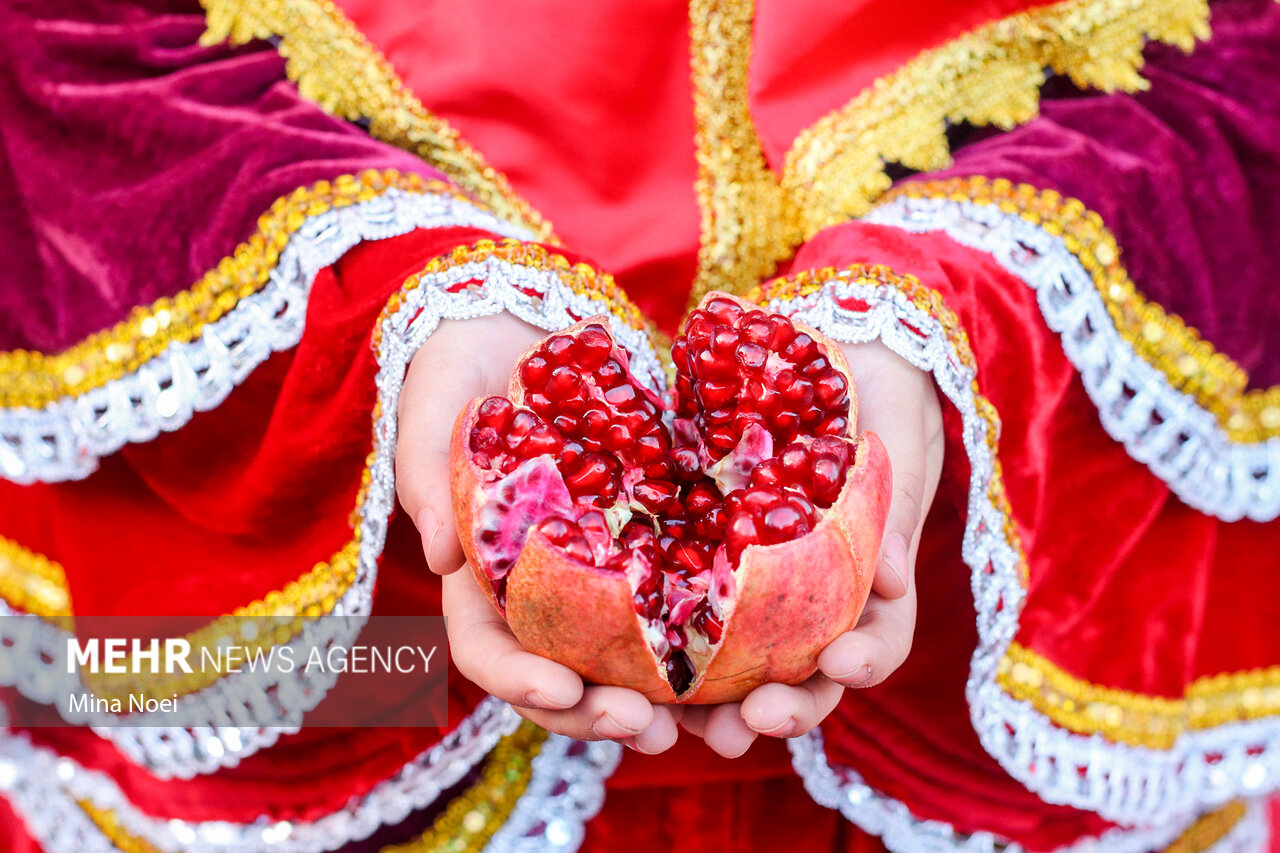Copyright mehrnews

In the heart of autumn, as the air turns crisp and leaves paint the streets in shades of amber, Iran celebrates a fruit that has woven itself into the very fabric of its culture: the pomegranate. Known as “Anar” in Persian, this small, ruby-red treasure is more than just a fruit, it is a symbol of abundance, beauty, and tradition, cherished across generations and regions of the country. Every October, families, markets, and festivals pay homage to its presence, filling homes with its scent and color. Walking through local bazaars on this day, one can feel the pulse of history and culture intertwined in every stall. Farmers display glistening pomegranates harvested from orchards in different parts of the country, while vendors share stories of ancient cultivation methods passed down through centuries. The fruit’s delicate seeds, encased in a leathery crimson shell, have long inspired poets, artists, and chefs alike, appearing in literature, painting, and culinary traditions as a reminder of life’s sweetness and resilience. Beyond their beauty, these fruits underpin local livelihoods, global trade and a surprising array of modern science, from cancer diagnostics to eco-friendly pest control. This report traces Iran’s pomegranate from orchard to table, revealing how an ancient fruit is shaping a modern nation.” The Cultural and Literary Significance of the Pomegranate in Iran The pomegranate has held a special place in Iranian culture for centuries, appearing in rituals, celebrations, and daily life as a symbol of fertility, prosperity, and divine blessing. From traditional weddings to Yalda Night (the longest night of the year), it is often present on tables, its seeds representing life, abundance, and the promise of renewal. In rural villages, it is common to see families carefully harvesting the fruit together, preserving a tradition that links generations through both work and celebration. In Persian literature, the pomegranate is much more than a fruit; it is a poetic emblem. Classical poets such as Hafez and Saadi frequently referenced the pomegranate’s vivid red seeds and its sweet, tangy juice as metaphors for love, beauty, and the hidden treasures of the human heart. It is also a recurrent motif in Persian miniature paintings and storytelling, representing hidden depth, vitality, and the interconnectedness of nature and human emotion. The imagery of opening a pomegranate to reveal its countless seeds mirrors the literary exploration of life’s many layers, making it a favored symbol across centuries of Persian art and letters. Pomegranate in Iranian Cuisine In Iranian kitchens, pomegranate is more than just a seasonal fruit—it is a symbol of flavor, color, and tradition. Its tangy-sweet taste and jewel-like seeds enrich a wide range of dishes, bringing both visual appeal and cultural significance to every meal. From everyday family tables to festive gatherings, pomegranate’s presence reflects Iran’s deep culinary heritage. One of the most beloved uses of pomegranate is in Fesenjan, a slow-cooked stew made with walnuts and pomegranate molasses. The rich, nutty base combined with the tangy sweetness of pomegranate creates a complex and memorable flavor, traditionally served with duck, chicken, or meatballs. Another classic dish is Zeytoon Parvardeh (marinated olives with pomegranate), a popular appetizer in northern Iran. This dish mixes olives with pomegranate seeds, pomegranate paste, walnuts, and herbs, offering a perfect balance of sour, sweet, and savory notes. Pomegranate also finds its way into salads, rice dishes, and sauces. Its seeds add a burst of freshness and color, while pomegranate juice or molasses enhances the depth of stews and condiments. Whether used in a festive dish like Fesenjan or a simple table appetizer like Zeytoon Parvardeh, the fruit’s versatility and vibrant flavor make it an essential part of Iranian cuisine, blending taste with centuries of tradition. Pomegranate in Iranian Handicrafts The influence of pomegranate in Iran goes far beyond the kitchen. Its distinctive shape, vibrant red color, and symbolic meaning have inspired generations of Iranian artisans, appearing in a wide variety of traditional handicrafts. From miniature paintings and pottery to textiles and metalwork, the pomegranate often serves as a motif of fertility, abundance, and beauty. In Persian miniature art, pomegranates are depicted in garden scenes, wedding celebrations, and festive gatherings, emphasizing the fruit’s cultural significance. Similarly, in ceramics and pottery, artisans paint or carve pomegranates onto vases, plates, and decorative tiles, blending natural elegance with artistic craftsmanship. These pieces often showcase intricate patterns, reflecting both the form of the fruit and the cultural narratives surrounding it. Textiles also bear the mark of the pomegranate motif. In Persian carpets and embroidery, pomegranates appear as repeating patterns or central symbols, symbolizing prosperity and life. Jewelry makers incorporate pomegranate shapes into pendants and charms, preserving the fruit’s symbolism in wearable art. Across these crafts, the pomegranate is more than decoration, it embodies centuries of cultural identity, connecting everyday life to the richness of Iranian heritage. Pomegranate and Yalda Night One of the most iconic appearances of the pomegranate in Iranian culture is during Yalda Night, the longest night of the year, celebrated on the winter solstice. Families gather to mark the occasion with poetry, storytelling, and a spread of seasonal fruits—pomegranates taking center stage. The fruit’s deep red seeds symbolize life, warmth, and the glow of the sun during the darkest time of the year. During Yalda, pomegranates are often served whole, sliced, or as part of special dishes and desserts. Their presence is not merely decorative; they are a symbol of hope and renewal, reminding families that light will return and days will gradually grow longer. In many households, pomegranates are arranged alongside watermelons, nuts, and other fruits, forming vibrant, festive displays that engage both the eyes and the palate. Beyond the dining table, pomegranates in Yalda celebrations also carry poetic and symbolic significance. Iranian poets have long associated the fruit with love, beauty, and fertility, making it a natural companion to readings of classical verses from Hafez or other Persian literary treasures. In this way, the pomegranate enriches Yalda Night, weaving together cultural heritage, culinary delight, and poetic tradition. Pomegranate Festivals in Iran Iran celebrates the pomegranate not only at home and on Yalda Night but also through local festivals that honor this iconic fruit. These festivals, often held in pomegranate-producing regions like Saveh, Yazd, and Behshahr, draw both locals and tourists eager to experience the fruit in all its forms. Visitors can taste fresh pomegranates, sample pomegranate-based dishes, and watch traditional performances that accompany the harvest season. Each festival usually showcases a variety of pomegranate-related activities: farmers display their best produce in competitions, artisans present handicrafts inspired by the fruit, and cooking demonstrations highlight local recipes that feature pomegranate as a key ingredient. Beyond the food, festivals often include music, dance, and poetry readings, reinforcing the fruit’s deep cultural and historical significance. These events also serve as an important opportunity to educate the public about the agricultural and nutritional value of pomegranates. Visitors learn about traditional cultivation methods, the seasonal cycles of the fruit, and its uses in culinary, medicinal, and artisanal contexts. In doing so, pomegranate festivals become a lively celebration of Iran’s agricultural heritage and a reminder of the cultural richness tied to this ancient fruit. Health Benefits of Pomegranate Pomegranates have long been valued in Iran not only for their taste but also for their nutritional and medicinal properties. Rich in antioxidants, vitamins, and minerals, the fruit supports heart health, strengthens the immune system, and aids digestion. Traditional Persian medicine also highlights pomegranate as a remedy for inflammation, high blood pressure, and fatigue, demonstrating a long-standing appreciation for its healing qualities. Modern science confirms many of these claims: studies show that regular consumption of pomegranate juice or seeds can reduce cholesterol, improve blood circulation, and even help prevent certain types of cancer. Its high fiber content also promotes digestive health, while the abundance of vitamin C supports overall immunity. Beyond the physical benefits, the fruit’s vibrant color and taste are believed to have a mood-boosting effect, making it both a healthy and joyful addition to the diet. In Iran, the integration of pomegranate into daily life—from eating fresh seeds to incorporating it into syrups and herbal remedies, reflects a culture that values the connection between food, health, and tradition. Pomegranate Exports: From Iran to the World Iran is among the top producers of pomegranates globally, with several regions, including Yazd, Markazi, and Fars, known for their high-quality varieties. Beyond its cultural significance, the fruit has become an important economic asset, bringing Iranian flavors to international markets. Each year, thousands of tons of fresh pomegranates, pomegranate juice, and even processed products like pomegranate paste are exported to countries across the globe. These exports not only generate revenue but also serve as a cultural ambassador, introducing global consumers to a fruit deeply embedded in Iranian heritage. Iranian exporters are increasingly focusing on sustainable cultivation, careful packaging, and quality certifications to meet international standards. This ensures that the richness of Iran’s pomegranates, both in taste and tradition, travels safely from local orchards to tables around the world, highlighting the fruit’s dual role as a cultural icon and a driver of economic growth. Pomegranate: A Legacy of Culture and Taste From ancient poetry to festive traditions, from the kitchen to the artisan’s workshop, the pomegranate holds a special place in Iranian culture. Its presence in literature, cuisine, crafts, and festivals shows how a single fruit can embody centuries of history, creativity, and social life. Iranian cities, towns, and villages celebrate the pomegranate in myriad ways, ensuring that its cultural, culinary, and medicinal importance is passed down through generations. While this report highlights key aspects of the pomegranate’s role, almost every region in Iran has its own unique traditions, dishes, and stories centered around this iconic fruit. In this sense, the pomegranate is not just a fruit, it is a symbol of heritage, health, and the enduring spirit of Iranian culture. Reported by Mohaddeseh Pakravan



